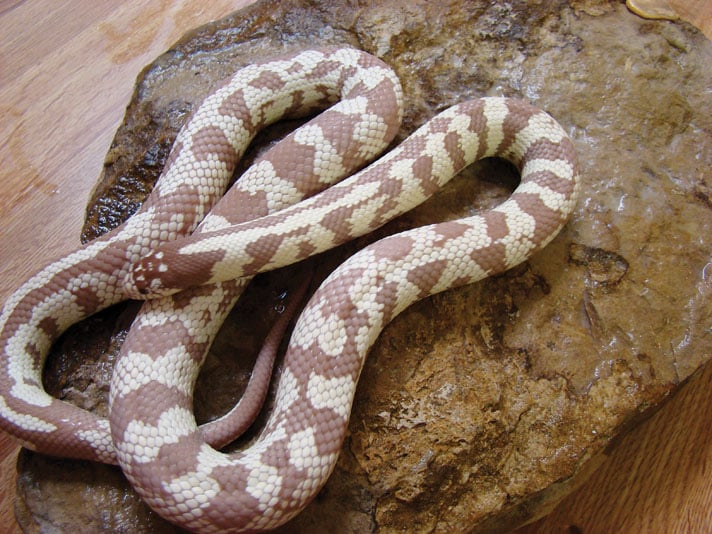Captive breeding and new morphs keep this favorite pet snake fresh and exciting.
California kingsnakes (Lampropeltis getula californiae) are popular and attractive colubrids that, despite their common name, are found not just in California, but also in Arizona, Nevada, Utah, Oregon, Baja and Mexico. They can be found anywhere from near sea level to more than 6,000 feet in elevation, where they occupy diverse habitats ranging from low desert to coastal and high desert mountains. They are great stalkers and can find food just about anywhere, eating basically any rodent, bird, other reptiles, including other snakes, and eggs that occur within their home range. They have a strong sense of smell and can detect prey from quite a distance, and depending on the time of year and temperatures, California kingsnakes may be diurnal or nocturnal.
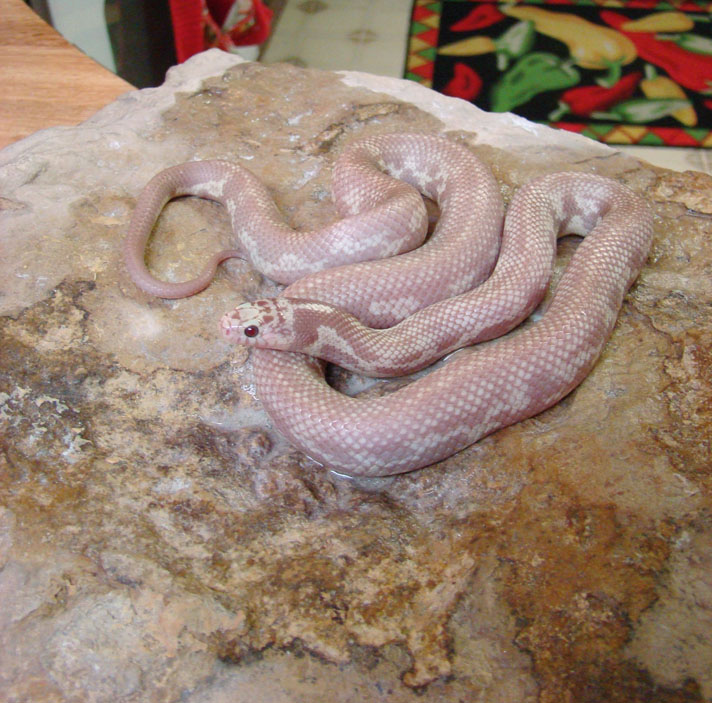
kerby ross
Coral Ghost (displaying Hypomelanistic and Ghost).
The appearance of the California kingsnake is very variable, depending on various factors, including location. In Arizona, for instance, the basic pattern is black or brown with yellow, cream or white bands. In parts of California, there are striped and aberrant patterns. In southern Arizona, the California kingsnake naturally intergrades with the desert kingsnake (L. g. splendida) and the Mexican black kingsnake (L. g. nigrita), and numerous specimens have been found that display these intergrade colors and patterns.
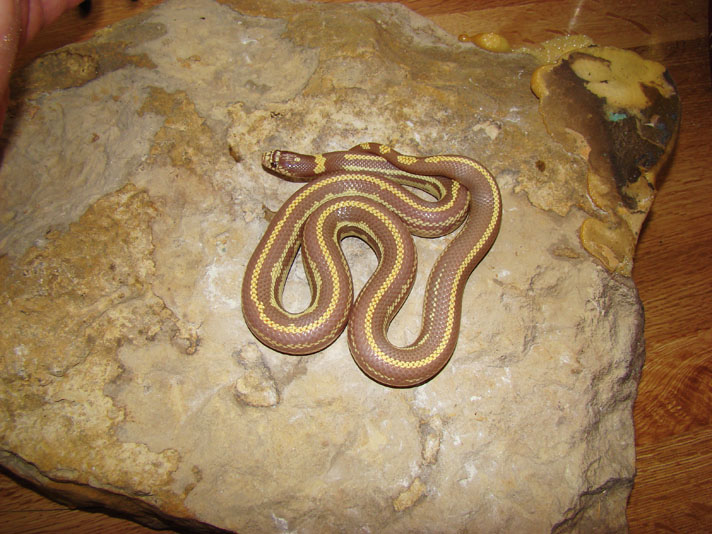
kerby ross
Striped Hypomelanistic.
California kingsnakes have been in the reptile trade for years because they make great pet snakes. They are easy to take care of, and they usually adapt to being handled very well. Because adult Cal kings usually max out at around 3 to 4 feet in length (though they can sometimes exceed 6 feet), they require less space than many other pet snakes, including most boas and pythons. They can be long-lived pets, too, living for 20 or more years in captivity. As with many of the most popular pet reptiles these days, California kingsnakes are bred regularly in captivity, and captive-bred snakes usually make the best pets.
California Kingsnake Enclosure
If you want to build a huge, naturalistic cage with a forest in it for your kingsnake, then go for it. Just remember, though, that kingsnakes are cannibalistic and you won’t be able to keep more than one snake in the enclosure. Such enclosures can be more work to maintain, too.
Most hobbyists opt for simpler, less elaborate setups for their California kingsnakes. Hatchlings and juveniles will do fine in a 10-gallon aquarium or similarly sized enclosure measuring about 20 inches long, 10 inches deep and 12 inches tall. A 20-gallon long tank measuring 30 inches long, 12 inches deep and 12 inches tall works well for an adult. Although California kingsnakes are capable of climbing trees to go after birds’ eggs, branches don’t need to be inside the enclosure for anything other than decorative purposes.
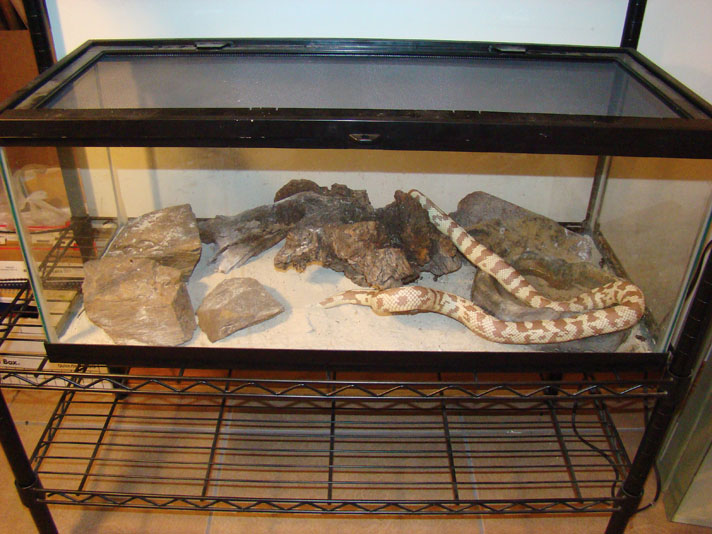
kerby ross
A 20-gallon long tank measuring 30 inches long, 12 inches deep and 12 inches tall works well for an adult.
I recommend a hide box so your kingsnake will feel secure in its environment. Hide boxes come in many forms, from artificial rocks/caves you can purchase in pet stores, to a simple cardboard box. The snake won’t care as long as it provides a hiding place.
Want To Learn More?
California Kingsnake Care Sheet
A water dish is necessary, and the water should be replaced and the dish cleaned frequently to ensure clean, fresh, drinking water.
I use both aspen and pine shavings for my kingsnakes’ bedding. I know some people prefer to avoid pine shavings because they’re dusty, but none of my snakes have ever been affected by them. If you’re worried, stick with aspen. Cedar bedding is definitely not recommended due to its toxic properties. That’s one reason why people have cedar chests and closets, after all-because cedar functions as a bug repellent-and those same properties can endanger reptiles. Newspaper works, too. Whatever you choose to use, observe your snake to ensure it does not have a negative reaction to whatever bedding material you choose to use.
Snakes are cold-blooded and their body temperature is near air temperature. Snakes in the wild will seek out optimal temperatures, whether they want to cool off or warm up. It is our responsibility to offer pet snakes the same choice of temperature ranges. I use the ambient room temperature to control my snake enclosure temperatures during the summer—it’s as easy as opening and closing the window. During the spring and fall I keep a space heater in the room to keep the room temperature comfortable for the snakes. This warms the front of the cages, and they remain cooler toward the back.
I try to maintain ambient temperatures in the 80s Fahrenheit during the day, and allow them to drop to the 70s at night.
In addition to manipulating the ambient air temperature, a supplemental heat source, such as an undertank heating pad, can help maintain a warm end and a cooler end in your snake’s enclosure. Heating devices that heat from below are better for snakes than overhead heat sources such as heat lamps. I don’t recommend hot rocks, and UV lighting is also not necessary for kingsnakes (although I don’t use them, other people do because they believe exposure to UV light may provide “psychological” benefits to the snake).
Equally important is for your snake to be exposed to a normal day/night light cycle. Aside from any home lighting that may be used in the room where you keep your snake, natural sunlight should be permitted into the room. Snakes do not need to be kept in direct sunlight—placing the enclosure in direct sunlight can actually be dangerous—but I believe indirect sunlight is important, as is exposure to a normal 24-hour day/night cycle. Throughout the year your snake should be able to experience the natural day/night cycle with the longer days occurring during the summer.
What to Feed a California Kingsnake
I feed my California kingsnakes pre-killed mice. I start with live mice, but I thump them before offering them to my snakes. I never leave a live mouse with a snake, unless it’s a pinky mouse. I breed my own mice and feed pinkies to new hatchling snakes. I believe feeding pre-killed mice is more natural and, at least in the case of my snakes, it prompts a better feeding response.
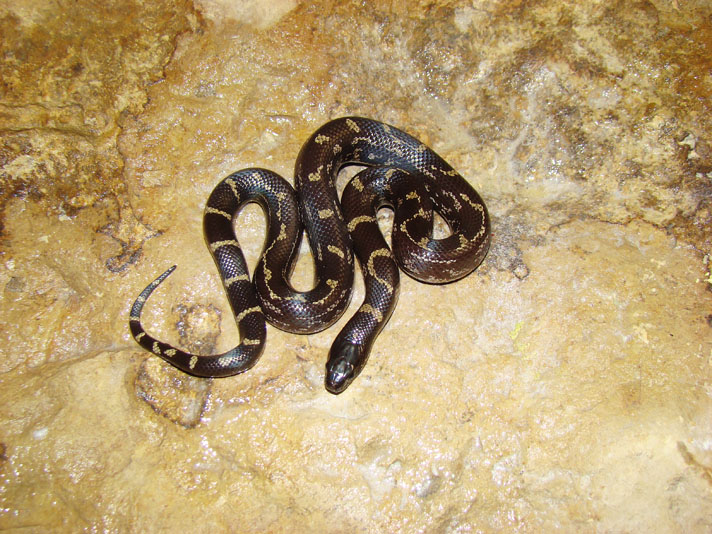
kerby ross
Hypermelanistic.
I do not power feed my snakes. Males get one mouse a week. Females, too, though sometimes I will feed two mice a week to females I plan to breed. Gravid females and those that have laid eggs are offered two mice twice a week. I do not recommend handling a snake until a couple of days after feeding, to allow for proper digestion. Washing your hands prior to handling will ensure that you do not have any rodent smell on your hands, which could otherwise trigger a feeding response and result in a bite. Besides, washing your hands before and after handling your snakes is just good hygiene.
Breeding California Kingsnakes
I begin breeding my California kingsnakes right after the females finish their first shed after coming out of brumation (see sidebar, page 36). In the wild, male California kingsnakes track females by following their pheromone trails. Once a male smells a female’s pheromones, breeding is all he wants to do. I always leave a female’s shed skin in her cage so the male can smell it when I introduce him. I always introduce males into females’ enclosures for breeding rather than the other way around.
Because California kingsnakes can be cannibalistic, I always watch them when I introduce the pair and periodically check on them while they are breeding. Breeding takes place if the female is receptive. It is common for the male to use his mouth to hold the female down while breeding; this is nothing to be alarmed about. When they are done, I return the male to his cage. I never leave California kingsnakes together except when they are actually copulating.
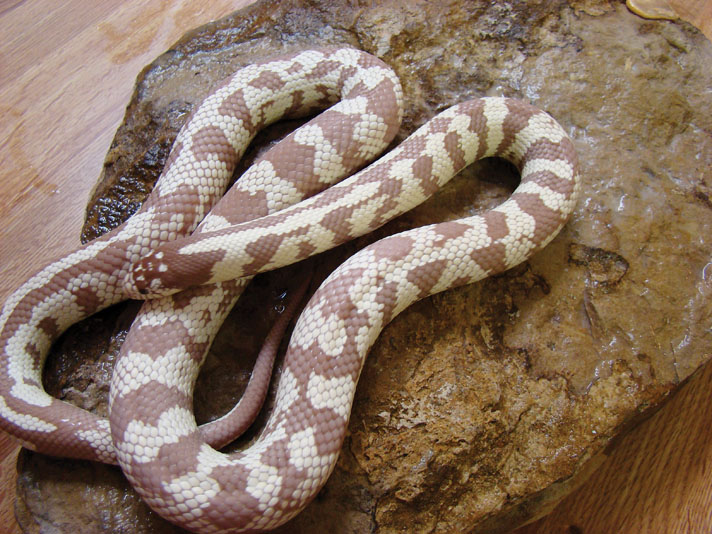
kerby ross
Hypomelanistic.
I feed the snakes only when they are separated. Males sometimes stop eating for a couple weeks during the breeding season, which is nothing to worry about. I will reintroduce the male into the female’s enclosure every couple of days until I am sure the female is gravid. Once she ovulates, six to 15 eggs are usually laid about six weeks later. Some breeders will double clutch (breed their snakes twice in one year), but I do not. I bring my snakes out of brumation in March, with most of them laying eggs in late June, July and into August. Because I am brumating them in October, there really isn’t much time to double clutch the females and allow them time to recover.
California Kingsnake Eggs and Babies
I provide gravid females with an egg-laying box containing moist vermiculite. Most, but not all, female California kingsnakes will go through a shed before laying their eggs. I remove them as the female is laying them, to place the eggs in the incubation container. If they are stuck together and have been recently laid, I will gently peel them apart. If they have been stuck together long enough to be more strongly adhered to each other, I’ll leave them that way. The female will be tired after laying her eggs and will usually just lay there with her eggs until she recuperates enough to go look for food. Do not confuse this with maternal care.
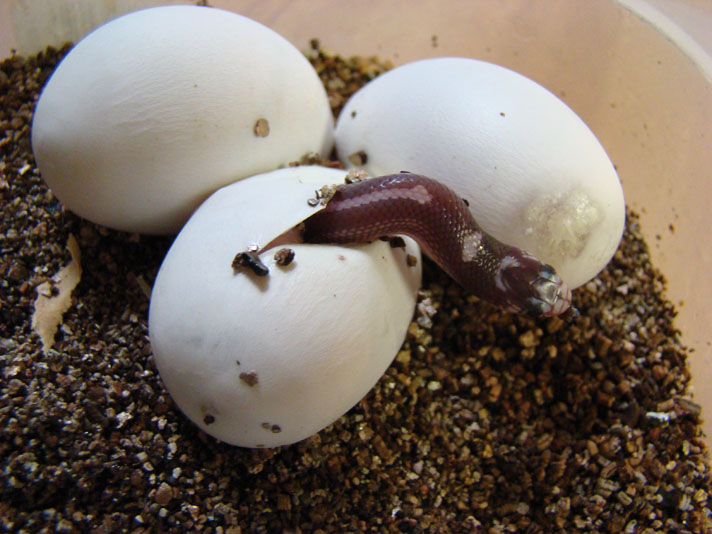
kerby ross
A California kingsnake coming out of its egg. It takes about 60 to 70 days for the eggs to hatch.
My incubation set up is simple. I use moist vermiculite for the incubation medium, placed inside a Tupperware container. I get my vermiculite in large bags from the garden center at Home Depot. The vermiculite should not be too wet—it should be moist, but not wet enough to wring water out of it—and do not bury the eggs in it. I drill two small ventilation holes into the lid of each incubation container, and I keep the containers on a shelving unit in my snake room, where the temperature fluctuates from the mid 80s during the day to the high 70s at night. I rarely have to add water to the containers, even though it is arid out here in Arizona. As long as I can see some water condensation on the inside of the containers, then all is good.
It takes about 60 to 70 days for my California kingsnake eggs to hatch. I normally do not assist in the hatching process. Baby California kingsnakes have a small egg tooth used to slit the egg open (the egg tooth disappears soon after hatching). After the baby snakes have pipped, they will remain in their eggs for a day or so while they absorb their yolk sacs. Most will emerge from their eggs looking as if they have swallowed a large pinky.
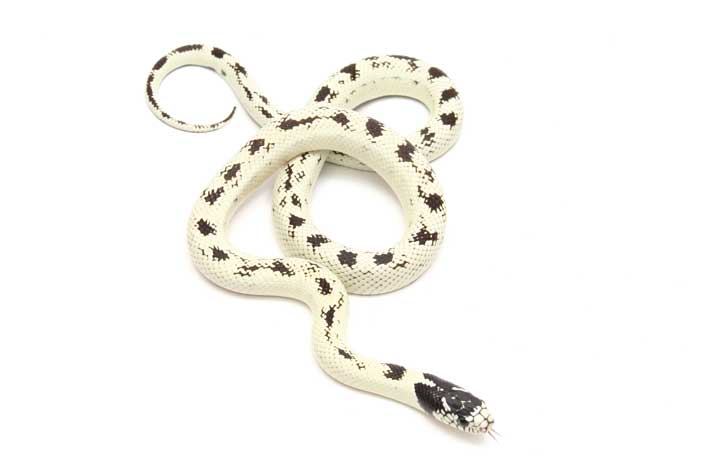
gina cioli
Banana.
Once the hatchlings have left their eggs I probe them to determine their sex before placing them into small, individual containers. After their first shed I offer them their first live pinkie mouse. Not all snakes will feed right after their first shed, but I offer each one a live pinky mouse every week. Because most of my snakes hatch during August and September, it will not be long before I brumate them. For those few finicky non-feeders, I will try either lizard scenting the pinkies or braining them (exposing the brain). That works for most of the non-feeders. Any that still have not eaten by the time brumation comes around will be brumated with the rest of the snakes. They will feed in March when I bring them out of brumation.
California Kingsnake Morphs
Although I have been breeding snakes since the early 1990s, it wasn’t until 2000 that I decided to specialize in California kingsnakes. At that time I was also breeding a lot of corn snakes, and I witnessed the diversity that corn snake breeders were producing. But nobody was doing it with California kingsnakes, so that became my mission.
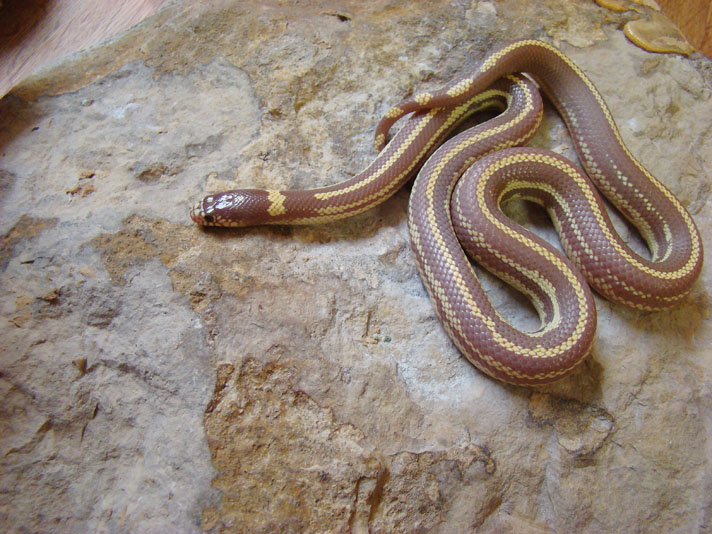
Kerby Ross
Striped Hypomelanistic.
It takes awhile to develop something new in the reptile industry. Nobody was going to hand me a rare wild-caught specimen and I was not going to wait until something rare just happened to pop out of a clutch by chance. I was very specific about what I was after. Besides the common California kingsnake recessive genes of albinism and lavender, I embarked on a quest to obtain the others that existed.
I acquired the Mendota hypermelanistic California kingsnake from Bill Cobb, and the Davis hypermelanistic California kingsnakes from Rick Staub. I picked up the Ghost/Palomar California kingsnakes from BHB Enterprises. My High Whites came from Steve Osborne. My Carlsbad stripers were wild caught. I got my Blue-Eyed Blondes directly from VIVID Reptiles and my Blizzard (albino and hypermelanistic) California kingsnakes from Shannon Brown. I picked up my hypomelanistic California kingsnake at the Tucson Reptile Show from a dealer who got it from Great Valley Serpentarium. I was pretty happy with the genetic ingredients these snakes would bring, and I could not wait until they reached breeding age, when I could begin deciding which to breed to achieve a desired result.
One of the frustrations with breeding California kingsnakes is the small clutch size (six to 15 eggs) as compared to corn snakes (eight to 30). Producing double hets is easy—just breed two snakes that are displaying two different recessive genes. The babies will be normal looking, but are double hets. When breeding any double hets together the odds of getting a snake to display both recessive genes is one in 16. With corn snakes that lay large clutches of more than 16 eggs, it’s easy to get that snake. With California kingsnakes, though, it can take a couple of years.
Through my breeding projects, I was able to confirm that the Davis and Mendota hypermelanistic locales were the same recessive gene, and that it was the same hypermelanistic gene in the Blizzard California kingsnake. I know some people used the Baja (nitida) hypermelanistic California kingsnake to create their Blizzards—it is all the same recessive gene.
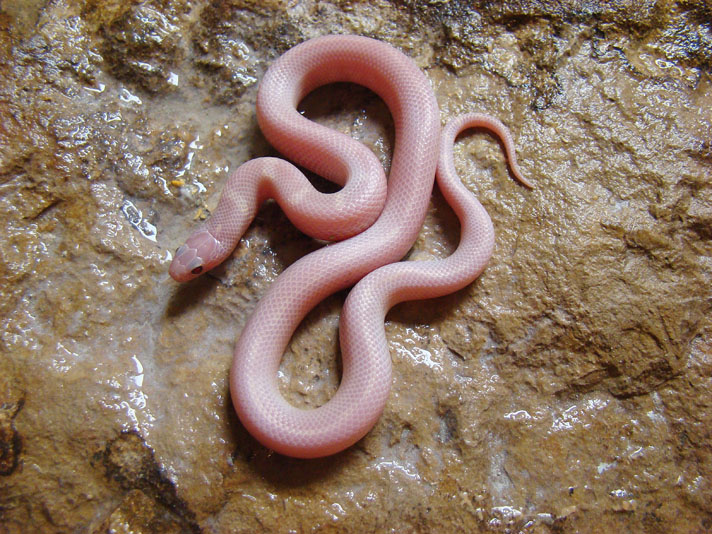
kerby ross
Purple Passion (displaying both Hypermelanistic and Ghost).
I combined the Ghost/Palomar gene with the hypomelanistic gene to produce the first-ever Coral Ghost California kingsnakes. Combining the Ghost/Palomar gene with the lavender gene resulted in the first Pink Pearl Ghost California kingsnake, and combining the Ghost/Palomar gene with the albino gene produced Casper Ghost California kingsnakes (also known as Iridescent California kingsnakes). I also have produced the light-phase Ghost/Palomar and the dark-phase Ghost/Palomar California kingsnakes. At the time of this writing, I am still working on combining the Blue-Eyed Blonde and the hypermelanistic (Mendota and Davis) into the Ghost/Palomar gene.
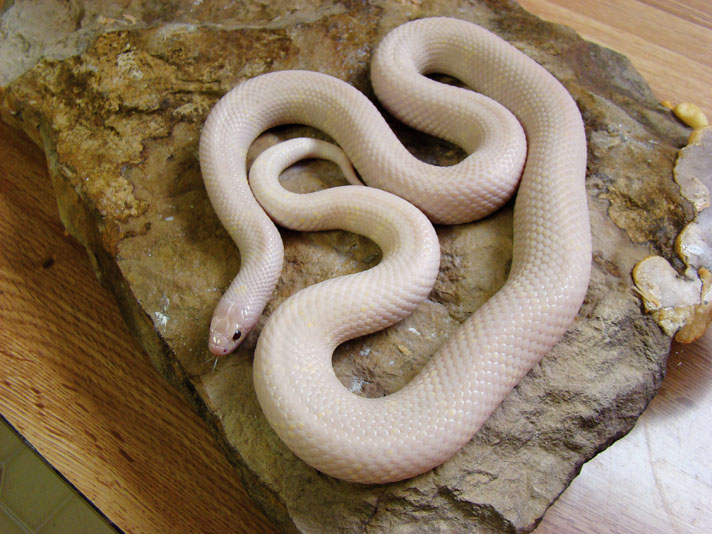
kerby ross
Casper Ghost (displaying both Albino and Ghost).
Besides the normal recessive gene combinations, there are also dominant genes. Striping in California kingsnakes is a dominant gene and is not recessive. So is high white, which resulted in the Aztec California kingsnake. Combining the dominant striped gene with recessive genes have produced striped lavender, striped hypermelanistic, striped hypomelanistic, striped lavender and striped albino California kingsnakes. And I believe there are striped Blue-Eyed Blondes, too. Soon we will see striped Ghost/Palomar and striped Coral Ghost California kingsnakes and others. Future California kingsnakes will be displaying three and four different recessive genes at the same time!
California kingsnakes make great pets, are easy to care for and fun to breed. Although I have produced some firsts in regard to California kingsnake morphs, I am not done. Others, too, are working on producing some cool California kingsnake morphs for the future. Exciting times are ahead!
Kerby Ross has bred snakes since 1991. In 2000, he decided to specialize in California kingsnakes, and he has since produced some new morphs with more in the works.

